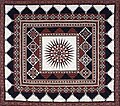This article needs additional citations for verification .(May 2018) |

Godadi or Gudri is a word used to refer to a quilt. A variant of the word exists in several Indian languages, including Hindi, Marathi, Urdu, Gujarati, Konkani, Kannada, and Punjabi, and other north Indian and southern languages and dialects. Godadi is a special kind of patchwork quilt which may be embroidered and is made of multiple kinds of cloth.
Contents
Traditionally, Godadi was handmade by housewives in various parts of India. In some places, such as Maharashtra, Gujarat, and north India, bits from used clothing, including sarees and dupattas, would be stitched together, sometimes in decorative patterns. In Konkan, very finely embroidered and intricately patched godadis are given as a part of bride's trousseau. In eastern India, especially Orissa and Bengal, they are also called "Kantha".
A variant of the godadi is razai, though razais are thicker and can also have cotton stuffing for more warmth during winters.




